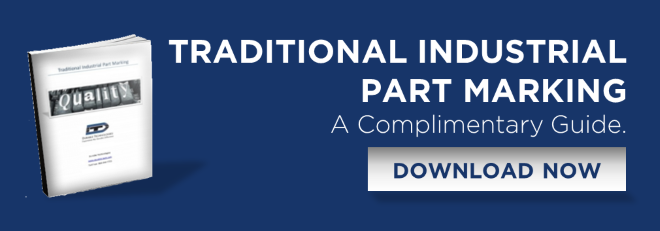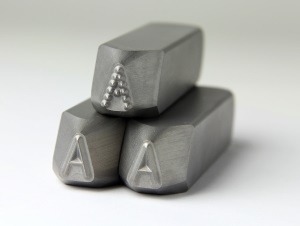
From low volume artisan shops to high volume industrial settings, direct part marking is used to add aesthetic touches, makers marks, required information, bar codes, and more to a wide variety of substrates. Because of the diversity of application specifications and needs, there are many marking methods to choose from. We break down some of the most popular marking methods below, from less complicated options that are ideal for low volume requirements to more industrial methods for high volume applications.
Hand Stamping
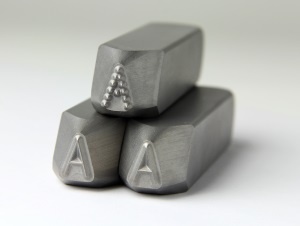 Hand stamping is a very popular, low volume marking method that is especially popular among hobbyists, craftsmen, and artists. Requiring only a hand stamp and a hammer, hand stamping has a very low barrier to entry and low upfront costs.
Hand stamping is a very popular, low volume marking method that is especially popular among hobbyists, craftsmen, and artists. Requiring only a hand stamp and a hammer, hand stamping has a very low barrier to entry and low upfront costs.
While hand stamping is an excellent solution for applications with low volume and simple marking requirements, it is not an ideal solution for applications where the requirements specify changing data, medium to high volume, or certain materials like glass and some plastics.
Hot Stamping
Another marking method ideal for lower volume operations, hot stamping also has a fairly low barrier to entry. Requiring a press, a logo die or type, and foil for color (optional), hot stamping can be used to mark alphanumeric text, monograms, images, onto a range of materials (cloth, leather, and ribbons) that other marking methods have trouble with.
Hot stamping does offer a number of advantages. First, this marking method is relatively easy to implement. The user needs to align the substrate correctly, but the press does the actual work of marking. Second, this is another marking method that allows for a great degree of customization since the logo dies and type can be easily tailored to the user's personal requirements.
Branding
Similar to hot stamping, branding irons can be used to mark most materials (other than metal and glass). Branding is also easy to customize and doesn’t require a complex set up. Branding irons are most often available as hand held portable units or in a drill press setup using custom engraved bronze dies.
Presses
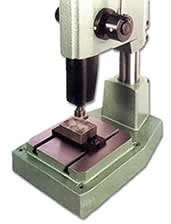 For higher volume marking requirements, a common marking method is to employ an impact press. Presses come in many sizes and can often be integrated into a production line. These presses are most commonly used for adding traceability information to parts, but can also be used to stake, rivet, crimp, and more.
For higher volume marking requirements, a common marking method is to employ an impact press. Presses come in many sizes and can often be integrated into a production line. These presses are most commonly used for adding traceability information to parts, but can also be used to stake, rivet, crimp, and more.
Custom shank stamps and type holders with interchangeable steel type can be employed for part marking requirements where one or more lines of copy are required. Numbering heads are also available for serializing parts. Pneumatic controls are available for higher volume marking requirements.
Ink Jet Printing
Ink jet printers exist to fulfill a wide variety of marking needs. From small hand held printers that can be used in the field to mark on the fly, to industrial inline ink jet printers that are commonly found in the food, beverage, and pharmaceutical industries.
Dot Peen
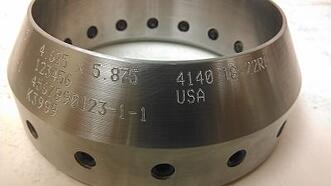 Another marking method often used in large-scale operations, dot peen marking machines are used to mark alphanumeric characters, logos, 2D data matrix bar codes, and much more in precise, low stress dot patterns.
Another marking method often used in large-scale operations, dot peen marking machines are used to mark alphanumeric characters, logos, 2D data matrix bar codes, and much more in precise, low stress dot patterns.
Sometimes referred to as pin stamp marking, dot peen marking equipment capabilities range from simple nameplate requirements to completely integrated solutions for marking components inline.
Learn More
Contact us to learn more about our full line of marking solutions. From low volume to industrial marking applications, we can help you find the right marking method and tools for your specific requirement.




